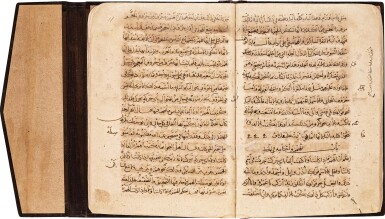Arts of the Islamic World & India including Fine Rugs and Carpets
Arts of the Islamic World & India including Fine Rugs and Carpets

ABU'L-QASIM ABD AL-RAHMAN IBN ISHAQ AL-ZAJJAJI AL-NAHWI AL-BAGHDADI (D.949 AD), KITAB AL-HIJJA'A (A TREATISE ON LINGUISTICS), NEAR EAST, CIRCA 1190 AD
Auction Closed
October 27, 04:55 PM GMT
Estimate
25,000 - 35,000 GBP
Lot Details
Description
ABU'L-QASIM ABD AL-RAHMAN IBN ISHAQ AL-ZAJJAJI AL-NAHWI AL-BAGHDADI (D.949 AD), KITAB AL-HIJJA'A (A TREATISE ON LINGUISTICS), NEAR EAST, CIRCA 1190 AD
Arabic manuscript on paper, 21 leaves plus 2 fly-leaves, 15 lines to the page, written in naskh in dark brown ink, modern leather binding, with flap
23.6 by 17cm.
Abu'l-Qasim abd al-Rahman ibn Ishaq al-Zajjaji al-Nahwi al-Baghdadi was a tenth-century master of the Arabic language and linguistics who travelled to Baghdad, Syria, and died in Palestine. He was a student of Abu Ishaq al-Zajjaj, Ibn Kaysan, Ibn al-Sarraj and al-Akhfash al-Asghar. He is credited with many works of lexicography and morphology and his most famous work, al-Jumal fi'l-nahw, a didactic introduction into Arabic grammar, went on to become a hugely popular textbook in the Arab world.
The present manuscript is on Arabic linguistics, comprising Kitab al-hijja’a (ff.1-18), followed by a short unrecorded treatise on the science of correspondence (unknown author). The Kitab al-hijja’a is an early (probably the earliest) copy of the work, with only one other known, in the Topkapi Palace Library (dated 707 AH/1308 AD, inv. no.1096, see Ghanim Qaduri al-Hamad, Kitab al-khat al-zajjaji, Amman, 2006, p.10).
The manuscript contains several commentaries in the margins that indicate the manuscript was collated against an earlier copy by a scholar, for example ff.5b, 6b and 10b. The date at the end of the manuscript is scratched and unclear but the style of the script and paper, as well as the similarity to the following lot, indicate a date circa 1190 AD (that colophon date of that manuscript).
